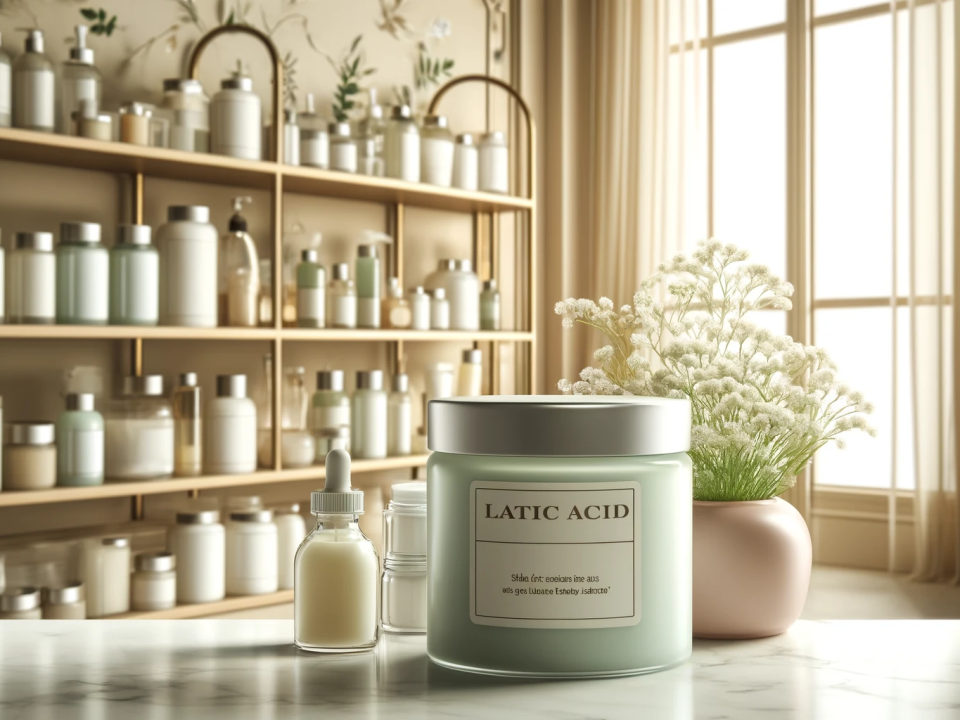
When And How Often Can You Use Lactic Acid For Your Skin?
May 9, 2024Incorporating lactic acid and other alpha-hydroxy acids (AHAs) into your skincare routine can yield transformative results, harking back to ancient beauty practices. Lactic acid, a derivative of sour milk, is renowned for its gentle exfoliating properties, making it suitable for almost every skin type. Whether you have sensitive, dry, or oily skin, integrating this AHA can significantly enhance your skin’s texture and radiance, proving that sometimes, the best beauty secrets are hidden in the most humble of sources.
However, it’s important to note that not all powerful ingredients play well together. For instance, combining lactic acid with vitamin C might not be the best strategy. When used simultaneously, these ingredients can disrupt the skin’s pH balance, potentially diminishing their effectiveness. To maximize the benefits of both, consider alternating their use between your morning and evening routines, ensuring each ingredient works optimally without interference.
The idea that sour milk derivatives can dramatically improve skin health might seem a bit odd, but the efficacy of lactic acid stands the test of time. This AHA is particularly praised for its gentle nature, allowing diverse skin types to reap its benefits regularly. By thoughtfully incorporating lactic acid into your skincare regimen, you can unlock age-old secrets to achieving a clear, glowing complexion.

What should you not use lactic acid for?
Lactic acid is much more than just an exfoliant; it’s a versatile skincare superhero. Found in products ranging from toners to moisturizers, this AHA boasts humectant properties, drawing moisture into the skin and helping maintain its balance. Its large molecules are gentle, preventing it from penetrating too deeply into the skin and reducing the risk of irritation. You’ll find lactic acid in a variety of products, including gentle cleansers, hand creams, and body lotions, making it a staple for anyone’s skincare routine. Despite its gentleness, it’s wise to conduct a 24-hour patch test before incorporating it into your regimen to avoid potential skin flare-ups.
Can I use lactic acid every night?
Absolutely, incorporating lactic acid into your nightly skincare routine is a viable option. Known for its milder exfoliating effects among AHAs, lactic acid gently removes the accumulation of impurities, dirt, and debris from your skin, which is essential after a day’s exposure. Additionally, its humectant properties prove invaluable at night, helping to replenish and maintain moisture levels in the skin barrier. This not only enhances the effectiveness of subsequently applied skincare products but also aids in repairing daily environmental damage to the skin.
However, it’s crucial to tailor the use of lactic acid to your skin’s specific needs and tolerance. If you’re new to using lactic acid, I recommend starting with an application just once a week in the evening. This cautious approach allows your skin to gradually adjust to the acid without overwhelming it.
As your skin becomes more accustomed to lactic acid, you might find it beneficial to increase the frequency of use. Over time, as your skin builds resilience, you could potentially expand its application to twice daily, ensuring your skin reaps the maximum benefits without irritation. This gradual escalation will help maintain your skin’s health and radiance, making lactic acid a valuable addition to your skincare arsenal.
Can you use lactic acid and vitamin C together?
Absolutely! Vitamin C is celebrated for its potent skin-brightening and rejuvenating capabilities. Rich in antioxidants, it dives deep into the skin’s lower layers, targeting dark spots and hindering the upward journey of excess pigmentation. This makes it an essential weapon in your skincare arsenal for maintaining vibrant and even-toned skin.
However, pairing vitamin C with lactic acid requires a careful approach, as the combination might be too intense for some skin types. Skincare gurus often suggest spacing out their usage—perhaps vitamin C in your morning routine and lactic acid at night. This strategic timing allows both ingredients to address similar skin issues effectively without overwhelming your skin. By mastering this method, you not only rejuvenate your skin but also fortify it against daily environmental stressors, ensuring a radiant and youthful complexion.
How long does it take for lactic acid to work?
Incorporating lactic acid into your daily skincare regimen can yield visible enhancements in your skin after just 4-6 uses. If you’re considering chemical peels, you might begin to notice a more radiant and softer skin texture after approximately two sessions, spaced one to two months apart. What’s great about lactic acid is its mild nature, allowing for daily application without harsh effects. However, it’s crucial to remember that transformation takes time; applying too much too often can lead to skin irritation.
Additionally, if you’re curious about how to safely combine lactic acid with other skincare ingredients, it’s essential to proceed with caution. Missteps can reduce the effectiveness of the products or even harm your skin.
Can you use lactic acid and hyaluronic acid together?
Certainly! Hyaluronic acid is a must-have for all skin types—its incredible water retention and hydrating properties are too good to pass up. Pairing it with lactic acid is like giving your skin an all-day moisture boost. The humectant qualities of both ingredients ensure a steady hydration supply, while lactic acid helps eliminate dead skin cells, paving the way for hyaluronic acid to penetrate deeper and enhance its effectiveness. This dynamic duo not only speeds up the reduction of fine lines and wrinkles but also strengthens the skin’s barrier, equipping it to fend off daily environmental stressors. Incorporating these into your skincare regimen means faster, visible results and a resilient, youthful complexion.
Should I moisturise after lactic acid?
Absolutely, it’s a great idea to follow up your lactic acid treatment with a moisturizer. Moisturizers do more than just hydrate; they are crafted with active ingredients that create a protective shield over your skin. This barrier is crucial for maintaining the balance of moisture and oils in the epidermis, which is your first line of defense against environmental aggressors. Daily hazards such as pollution, UV rays, harsh weather, and even central heating can disrupt this barrier, increasing the risk of various skin issues.
Applying a moisturizer after lactic acid not only preserves skin health but also enhances the effectiveness of the acid. This allows the treatment to perform optimally without interference from external elements that could potentially damage your skin. By incorporating this simple step into your skincare regimen, you’re setting the stage for a resilient, smoother complexion that is better equipped to withstand the challenges of everyday exposure.
Conclusion
In conclusion, when using lactic acid in your skincare routine, it’s crucial to avoid combining it with other strong actives such as retinol, glycolic acid, and vitamin C to prevent skin irritation and damage. Instead, opt for soothing and hydrating ingredients like hyaluronic acid, ceramides, and niacinamide that complement lactic acid’s exfoliating benefits. By understanding these interactions and carefully selecting your skincare products, you can maximize the effectiveness of lactic acid and achieve a healthier, more radiant complexion. Remember to patch-test new combinations and consult with a dermatologist if you have sensitive skin or concerns.




